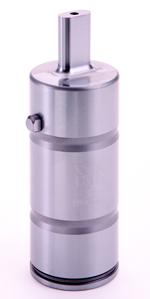- FMA
- The Fabricator
- FABTECH
- Canadian Metalworking
Treated Punching Tools
Specialty tool coatings boost punch press performance
- By Scott Tacheny
- September 1, 2011
- Article
- Fabricating

High-endurance surface enhancements create a hardness of 70 HRC, which boosts lubricity and lowers the coefficient of friction.
Under pressure to increase productivity and reduce costs wherever possible, more and more sheet metal fabricators are discovering the benefits of coated tooling.
For some fabricators, new materials are proving to be more difficult to process and may result in more frequent tool failures. For others, the need is quite simply to run jobs at higher speeds and with less downtime to improve productivity.
No matter what the reason is — increasing tool life, achieving more hits between sharpening, or minimizing galling (the material buildup on a tool’s surface) — specialty coatings can help punch press fabricators improve performance, decrease downtime, and ultimately, become more productive.
How Coatings Work
Coatings create a barrier between the tool steel and the material being hit, which helps to reduce galling, increase hardness, and improve lubricity.
Coating technology can boost tooling performance to levels far beyond that of untreated tool steels. This is why engineers for most tooling manufacturers are continuously experimenting with new coatings or variations of existing coatings. Each new coating is designed to overcome a specific punching challenge, such as stripping, galling, or punch wear.
For instance, fabricators experiencing galling when working with materials such as aluminum should consider a tool with a titanium nitride (TiN) coating. This type of coating can help resist galling, reduce stripping, and extend tool life during aluminum punching, forming, and piercing. Wilson Tool’s Wear-Beater™ coating is an example of a TiN-coated tool.
Titanium carbonitride (TiCN) coatings can reduce galling when processing stainless steel and galvanized steel and is virtually unaffected by sharpening. Tooling treated with this type of coating can even outlast untreated tools by as much as five to seven times.
Wilson Tool’s Optima® coating is an example of a custom-engineered TiCN coating. It was designed to improve surface hardness, wear resistance, and lubricity. The coating achieves a hardness of 95 HRC, which far exceeds hardness levels of conventional untreated tool steels.
As the challenges fabricators face continue to evolve, so too do the coatings and surface enhancements tooling manufacturers offer. Choosing the right tools depends largely on the specific challenge. Each provides distinct advantages depending on the issue faced.
Galling and punch wear are common problems encountered when piercing galvanized materials. Treating punches with a surface enhancement, such as a heat-treat process that improves lubricity, can minimize these problems.
Nitrex® is a high-endurance surface enhancement first developed for use on press brake tooling. But with a surface hardness of 70 HRC, which boosts lubricity and lowers the coefficient of friction, Nitrex has also proven to be effective for minimizing galling when piercing some materials on a punch press.
Difficult applications like aluminum punching and forming require a tool coating that will increase hardness and lubricity to resolve challenging stripping problems.
Perhaps the most significant benefit of any tool coating or surface enhancement is improved wear resistance. Tooling that is more resistant to wear results in less downtime for maintenance such as sharpening punches or even tool failures. And, tooling that lasts longer results in lower tool replacement costs.
In addition to improving wear resistance and increasing tool life, tool coatings also improve the quality of parts by providing a much cleaner punch. Higher-quality parts – those made with less galling and stripping during production — also result in considerably less waste being produced.
If you have punching applications in which your punch is producing excessive galling or your punches are wearing out faster than they should, specialty tool coatings may be the solution you need. They are available for nearly every application, tooling, and material.
Certainly there are costs to consider when purchasing new tooling, whether treated or untreated. When investing in new tooling for your shop, it is important to keep in mind not just the initial price of the tooling, but also the total cost over the life of the tooling. Lower-quality, untreated tools may come with an appealing price, but may cost more in the long run because of more frequent maintenance needs, more downtime, and unnecessary waste.
Investing now in higher-quality, more innovative tooling that has been designed to increase efficiency, reduce waste, and lengthen tool life will help you punch faster for longer, resulting in long-term gains in productivity and profitability.
Related Companies
subscribe now


Keep up to date with the latest news, events, and technology for all things metal from our pair of monthly magazines written specifically for Canadian manufacturers!
Start Your Free Subscription- Trending Articles
- Industry Events
MME Winnipeg
- April 30, 2024
- Winnipeg, ON Canada
CTMA Economic Uncertainty: Helping You Navigate Windsor Seminar
- April 30, 2024
- Windsor, ON Canada
CTMA Economic Uncertainty: Helping You Navigate Kitchener Seminar
- May 2, 2024
- Kitchener, ON Canada
Automate 2024
- May 6 - 9, 2024
- Chicago, IL
ANCA Open House
- May 7 - 8, 2024
- Wixom, MI















